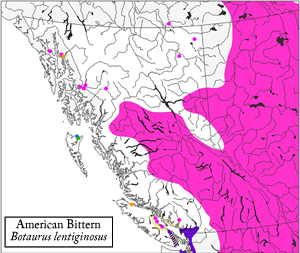Although this is a distinctive species, it may potentially confused with immature Black-crowned Night-Heron, which is superficially similar in size, shape, and plumage pattern. Immature Black-crowned Night-Herons, however, are somewhat smaller and stockier, with a shorter, heavier, and darker bill and red iris (iris yellow in American Bittern), and lack the bittern’s distinctive dark malar stripe and bold chestnut streaks down the front of the neck and onto the breast. Furthermore, immature Black-crowned Night-Heron has bold whitish spots on the wing coverts, whereas in American Bittern the upperparts (including the wing coverts) are entirely smudgy brown.
| During the breeding season, the male gives a characteristic loud, deep, thumping, resonant BLOONK-Adoonk or PUMP-erlunk; this call has a gulping, swallowed quality that is unlike any other bird and is highly distinctive within its marshy habitat. Also gives a repeated kok kok kok when flushed, as well as a loud, hoarse, nasal squark or haink when flying. Source: Sibley (2000); Lowther et al. (2009) |
Courtship
Pair formation occurs immediately following the arrival of females on the breeding grounds. The booming calls of the male serve as the primary means of attracting a mate in the densely vegetated marsh habitats that this species prefers, although several pre-copulatory displays such as drooping of the head, “retching” movements, and fluffing of the white feathers beneath the wing (“shoulder plumes”) occur when the female is at particularly close range. Unlike most other herons, copulation in American Bittern is not solely confined to the nest but rather occurs throughout the male’s territory. Male American Bitterns are often polygamous, with multiple females nesting within the territory.
Nest
The nest is typically well-concealed and built among dense emergent vegetation over water that is 5-20 cm deep, although some nests are constructed in drier upland vegetation or moist meadows where they are concealed by tall, dense herbaceous vegetation. Only the female builds the nest, which consists of a platform of reeds, sedges, cattails, or other emergent vegetation that is lined with finer grasses. All nest materials are collected from the immediate vicinity of the nest, and thus the types of vegetation used in its construction are somewhat variable. The nest platform is 25-60 cm across and is raised 8-20 cm above the surface of the water (or, for terrestrial nests, the surface of the ground).
Eggs
A single clutch of (2) 3-5 (7) smooth, slightly glossy, unmarked olive-buff eggs is laid between mid- to late April and mid-June (exceptionally as early as early April), with most clutches initiated during May. The eggs are incubated by the female for 24-28 days before hatching. Although this species is single-brooded, females will lay a replacement clutch if the first clutch is lost. Eggs are present in British Columbia between early April and mid-July.
Young
The nestlings are altricial and downy at hatching, with yellowish-olive down (darker above), a flesh-coloured and black-tipped bill, a pink mouth, and light olive eyes. The nestling are tended solely by the female and depart the nest within 1-2 weeks of hatching. Following departure from the nest, the young remain in the vicinity of the nest for an additional 2-4 weeks, during which time they receive supplemental feeding from the adults. Nestlings occur in British Columbia between early May and mid-August, with most broods occurring in June and July.
Source: Campbell et al. (1990a); Baicich and Harrison (1997); Lowther et al. (2009)
|
This species feeds on aquatic and terrestrial insects, small fish, amphibians (including frogs, tadpoles, and salamanders), snakes (especially garter snakes), and small mammals (especially voles) that inhabit marshes and other wetland habitats. It employs several different strategies for hunting, including still hunting, neck swaying, and walking (both slowly and quickly), and prey are captured with a rapid, sudden dart of the head and seized with the long, pointed bill. This species hunts along the fringes and shorelines of wetlands, rarely leaving areas of cover to pursue prey in the open, and virtually always hunts alone. The colouration of the bird is extremely well camouflaged with the emergent vegetation (e.g., cattails) in which it occurs, significantly reducing its visibility to prey (as well as predators).
Source: Lowther et al. (2009)
|
|

